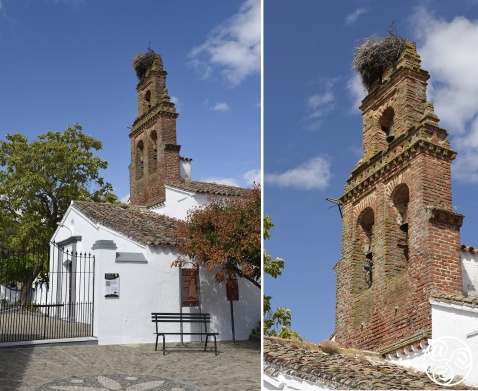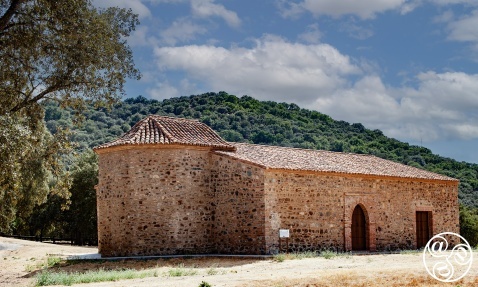
Iglesia de Nuestra Señora de Gracia. The Church of our lady of Grace, La Nava |
|
LA NAVA
by Saskia Mier
La Nava is a small village located in the Sierra de Aracena and Picos de Aroche, north of Jabugo. Located at a crossroads in the heart of the Sierra, La Nava dominates the valley of the Rio Múrtigas (river), rich with orchards surrounded by hills of oak and olive trees. It has approximately 300 inhabitants.
HISTORY
There are several archaeological sites that show the existence of previous inhabitants of La Nava. The three most important are Papatortas, Valdegalaroza and the Sierra de Algaba. Thanks to the Turdetanos (pre-Roman Iberian tribe who occupied a region stretching from the Algarve to the Sierra Morena), Sierra de Algaba had farmers and miners from around 500 B.C.
The arrival of the Romans in La Nava also resulted in various mining operations in the area, extracting iron, copper and silver, and building a small village to accommodate miners, close to the Ermita de la Virtudes (which was built using stones from the miners' settlement). During the decline of the Roman Empire, the mines were abandoned, leading to the village's depopulation during the Visigothic period.
From then until the eighth century, La Nava was almost deserted, but the arrival of the Arabs revived the areas farmers exploited the land's riches. The miner's village was destroyed, and new settlers moved to what is now La Nava for its agricultural prospects. Dams, canals and mills were built on the river Múrtigas to irrigate the orchards.
The Christian conquest was carried out by Portuguese King Sancho II between 1230 and 1235, and passed onto the Crown of Castille in 1255. Archbishop Don Remondo divided the church to the Kingdom of Seville in 1261.
In 1311, the Portuguese obliterated crops and stole cattle, besides epidemics of plague that depopulated the village until 1341. Once the village increased in prosperity in the mid-15th century, the request to build new houses on the land was granted. Wars with Portugal in 1476 destroyed the village, so Queen Isabel I granted tax exemption to help the recovery of the people.
In 1811, Napoleon's French troops invaded, stealing bread and food for the poor and killing the mayor Robustiano Carvajal Arellano. The late 19th century brought prosperity as work began at several of the 86 mines that exist in the area.
Improved transport networks allowed for population growth from 1950 to 1960; when the Maria Luisa mine was closed in the 1970's, however,many villagers were forced to emigrate, resulting in La Nava's reduced population today.
THINGS TO SEE
Papatortas is west of La Nava towards the village of Puerto Lucia, where ceramic materials, as well as a necropolis from the third millennium BC have been found. Valdegalaroza, 2.5 km south of La Nava, along the N-435, is surrounded by large oak valleys, and has more ceramics and another necropolis from the second millennium BC plus other archaeological finds which can be seen in the Provincial Museum in Huelva.
Sierra de Algaba, with the best archaeological sites, is located in a beautiful,almost in accessible landscape with an imposing walled fortress that provided excellent defence against any enemy. Here, stone axes from the third millennium B.C have been found, as well as ceramics and Roman coins from the second century BC,showing the site has been inhabited for over 3,000 years.
Ermita de las Virtudes
Ermita de las Virtudes was constructed at the end of the 13th or early 14th century. However the construction was carried out in different phases including the 17th century, probably 1619 according to a graffiti. It is said that the chapel was erected on a Roman site because of the presence of reused Roman bricks, pottery and coins in the building's masonry. However a detailed study in 2013 found that the material were brought from other places.
The building is a typical Mudejar church of the rural upland north of Huelva. It has three naves separated by rectangular pillars with chamferred corners on which on which are placed transversal pointed arches. The central one is crowned with a rectangular section presbyter and another polygonal presbyter.
Inside, the beautifully restored building now serves as a musuem and includes works by Picasso, Miró and Dali. This exhibition opened in Jan 2023, Thur to Sun morning and afternoon. Otherwised by arrangement, call 959 12 10 79. Link to 360 Virtual Visit.
Cabildo Viejo
A 19th-century building in Plaza de España, used as the Town Hall until the 1980's but currently used as the library and computer centre. Inside there is a clock from 1905 which still works perfectly, thanks to repairs carried out by Don Jose Verdejo Carretero.
Humilladero del Cristo de los Caminantes
Small, simple chapel located at the crossroads halfway between the village and the Ermita de las Virtudes. Built in 1495, it has an image of Christ carved in wood by the sculptor Leon Ortega Huelva.
Iglesía Parroquial
This medieval church, located in Calle de las Virtudes,was built in 1509 with only two bronze bells, but was given a third in 1662. As a result of a lightning strike, one bell broke but kept chiming, and in 1968 the company Hidronitro Española S.A, owner of the Maria Luisa mine, replaced the bells with iron ones. In 1678 the chapel was added and an entrance was built in 1941.
Puentes
There are four bridges to see in the area of La Nava. Puente Medieval is situated in a bend of the river Múrtigas, next to the N-435 road, 500 m above the Puente del Infierno. Built by millers, possibly from Roman times, it is made of stone in a single arch. You can reach the ruins of an old mill by walking routes via this bridge. Puente del Infierno was built over the river Múrtigas in the 16th century and located next to the N-435 road. Puente del Batán was the third to be built in the same place, as the previous was too small and is located at the junction of the N-435 road, at the entrance of La Nava. Puente de las Botellas is located at the exit of La Nava, towards Extremadura, and its name comes from its bottle-shaped jetties.
Pilar del Agua Buena
Fountain built in 1888 next to the N-435 road, on the outskirts of the town and used as a watering hole for animals, although the water is drinkable as it is used by walkers too.
Hotels in La Nava
Book Hotels in La Nava
COUNTRYSIDE WALKS
La Nava-Cortegana (PR-A3) is 10 kms and takes around three hours. It starts in Calle Puerto Bajo, crossing the river Caliente, and finishing in Puerto Lucia. You can take an alternative route before the river Caliente leading onto Cortegana.
La Nava-Jabugo starts from Avenida del Puente, over Puente Batán and onto Jabugo.
La Nava-Galaroza starts in Callejón de la Vega, passing the Múrtigas river and onto Galaroza.
La Nava-Valdelarco (PR-A39) is 6 km and takes about three hours. Starts in Callejón de la Vega, passing the Múrtigas river, climbing up to Sierra de la Algaba until the Ermita del Salvador in Valdelarco.
La Nava-Repilado (PR-A39) is 5 km in length and takes around 1.5 hours.Starts from a section off La Nava-Jabugo, to Sierra de la Cadena, passing river Caliente and onto El Repilado.
GASTRONOMY
Popular dishes of La Nava include: cocido de gurumelos (Iberian pork stew with wild ceps),bollos de papas (mash made of potatoes, tomates and pork), picadillo de asadura (vegetable and pork salad), gazpacho de invierno (winter gazpacho) and olla de coles (cabbage with pork offal). The most typical dish of La Nava is orejas de cerdo (pigs' ears), usually served in a variety of sauces.
FESTIVALS
Patrona de Nuestra Señora de las Virtudes is celebrated on 14-15 August. On 15 August a procession takes place in the village.
Fiesta del Melocotón is celebrated the last week of August. A festival to celebrate peaches grown in the area. More than 300 kg are peeled, chopped finally and placed in cups filled with white wine from the Condado de Huelva.
Romeria de las Virtudes is a pilgrimage celebrated the last weekend of May and is said to be the oldest in Huelva province.
LOCATION
La Nava is located 100 km from Huelva. Taking the Autopista del Quinto Centenario, along N-435 passing Valverde del Camino, Santa Ana La Real and Jabugo. Continue along the N-435 to Jabugo.


